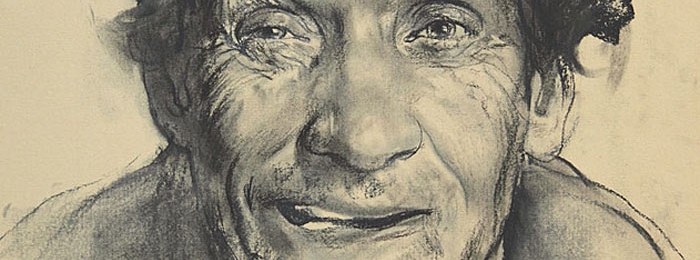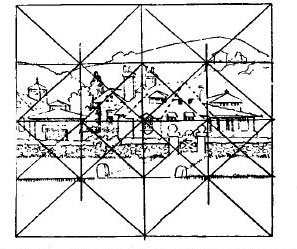Why using the triangulation drawing method is treacherous

Question from Kyle, Drawing Academy student
“Is triangulation an acceptable alternative method to find the end points or envelope of the object(s) being drawn?
I’ve been exposed to both the measuring method taught in the Drawing Academy course and the triangulation method I’ve learned elsewhere. I feel more comfortable with the triangulation method, because to me it seems easier. Am I cheating myself by not using the method taught in the Drawing Academy course?”
Hi Kyle,
Many thanks for your question.
To use or not to use the triangulation drawing method when learning to draw depends on your particular goal. Is it to be able accurately copy, or is it to become an original fine artist who can make realistic drawings from memory and imagination?
The triangulation method is good for someone who thinks that making art is the process of producing an exact copy of an image or an object. This makes such a craftsman a reproducer, rather than a fine artist.
The triangulation method is often used to copy portraits from photos as advised in some YouTube videos:

There are many amateur artists and so-called art teachers who advocate the triangulation method as the only accurate way to draw. They think this method is advanced just because some measuring is involved.
I don’t want to put down anyone who is teaching how to draw realistically with whichever method they use. They are doing an honorable job as so many art students graduate from art colleges with no drawing skills whatsoever. However, not possessing right teaching methods, they can’t pass good drawing techniques to next generations of artists.
I’m sorry for students who learn and use only this method, without being aware that it’s actually treacherous for the development of their drawing skills.
I know this is a bold statement, therefore will explain in detail why.
Why using the triangulation drawing method prevents learning good drawing skills:
1. It is the way to copy mostly from photos.
This video details reasons why drawing from photos prevents learning good drawing skills:
drawingacademy.com/why-drawing-photos-is-treacherous
2. It makes artists’ brain think two-dimensionally.

Measuring triangles is the way to “flatten” an object and copy three dots at a time without understanding what volume or construction this object has.
While copying dot-by-dot produces likeness in drawing, an artist will not be able to draw the same object realistically from memory, because there are no triangles to rely on and there is no understanding of how this object is constructed.
3. It prevents learning and practicing linear perspective.
 Perspective deals with how three-dimensional objects can be portrayed on a flat surface with minimal distortions. When copying by triangles, principles of linear perspective are discarded and an artist cannot use various kinds of perspective to depict an object in the best way. This requires a creative approach of choosing the right type of perspective, and sometimes combining several types in one drawing, such as one-, two-, and three-point perspective. It also requires good understanding of foreshortening. Using triangulation, a craftsman is simply copying in photo-perspective without understanding why objects are distorted in that way.
Perspective deals with how three-dimensional objects can be portrayed on a flat surface with minimal distortions. When copying by triangles, principles of linear perspective are discarded and an artist cannot use various kinds of perspective to depict an object in the best way. This requires a creative approach of choosing the right type of perspective, and sometimes combining several types in one drawing, such as one-, two-, and three-point perspective. It also requires good understanding of foreshortening. Using triangulation, a craftsman is simply copying in photo-perspective without understanding why objects are distorted in that way.
4. It prevents learning proper constructive drawing principles.
Apart from perspective, there are many other constructive drawing principles that help tremendously, such as constructing objects in drawing as if they are transparent, using axes of symmetry, alignment lines and so on. While copying triangles, many of constructive principles are set aside, thus artist do not learn what it takes to “construct objects” properly.
5. It prevents learning proportions of a human body.

Copying triangles has nothing to do with the knowledge of human body proportions. When a craftsman is facing the challenge of drawing a model from life, no triangles will help. Instead, a solid knowledge of human body, head, face, torso and limb proportions has to be in place. Such proportions cannot be learned by using triangles. This is even more apparent when an artist has to draw human figures and portraits from memory or imagination.
6. It prevents learning the human anatomy.

A human body is not made of triangles, it consists of bones and flesh and therefore the knowledge of anatomy is a must for a figurative artist. I have met so many art students in life drawing classes in London; most of them struggle from the first minute they start drawing a model. All those students have one thing in common – the lack of knowledge of a human anatomy for artists.
7. It prevents learning how to depict human emotions in portraits.

Emotions on a human face are created by certain groups of muscles in accordance to person’s feelings. A figurative artist must know those muscles and understand how they work. Triangles will not replace this knowledge, especially when an artist has to draw an imaginary face without a photo reference.
8. It prevents nurturing a skill of judging angles by eye.
Many craftsmen use rulers, sticks or pencils as measuring tools when practicing the triangulation method. While using a pencil for measuring angles is totally appropriate, there is a certain way to do it right – first an artist has to draw an angle by eye, and only then, if in doubt, check with a pencil. This trains the skill of judging angles by eye. Using the triangulation method by default puts measuring with a tool first, thus reducing ability of an artist to develop necessary skills.
9. It prevents from developing strong free-hand drawing skills.

Painting by Vladimir London. Watercolor on 100% cotton paper, Escoda brushes.
As one of the best artists ever lived, Michelangelo Buonarroti once said, “It is necessary to keep one’s compass in one’s eyes and not in the hand, for the hands execute, but the eye judges.” Triangulation method puts measuring tools in artist’s hand, limiting his or her ability to learn drawing free-hand.
9. It prevents artistic exaggeration and freedom of expression.

Painting by Vladimir London. Oil on 100% cotton paper, Escoda brushes.
When making an exact copy of a picture or an object, a craftsman reproduces an image rather than creates through one’s mind, eyes and hands an artistic vision of a model. Artistic creation sometimes requires exaggerations, creative input and, above all, the freedom of expression. No triangles will help to express creativity.
10. It traps the artist into copying mode, which is very difficult to escape.
Once a craftsman has learned and gotten used to copying, it is very hard to escape such trap. The reason is not in one’s wish, but physical ability. The craftsman’s brain has been re-wired to see and to copy two-dimensional images rather than understand objects as things with volumes, masses, construction, and spatial relationships. This is one of the most dangerous points in this list and explains the word “treacherous” in my statement.
11. Is copying an art or reproduction?
You have to ask yourself this question and decide what is your goal in art – to able to copy or be an original creator.
If your ambitions extend no further than making a good copy of an image, then the triangulation method is as good as any other reproduction ways – photographing, printing, tracing images, and so on. However, if your aspiration is to tell the story through your art, convey emotions, deliver a message, create original things from your mind, you need to have adequate skills to be such an artist.
Such skills include use of constructive drawing principles, linear and aerial perspective, good knowledge of a human body anatomy and proportions, understanding and use of golden ratio, rules of composition and so on. This is what we teach in the Drawing Academy course and Anatomy Master Class.
I hope this answers your question “are you cheating yourself?”
Best regards,
Vladimir
To learn professional drawing techniques,
- Receive 15 new videos monthly (45 in total)
- Incredible discount – $4,164
- Bonuses - Fine Art eBooks and Videos
- Drawing Academy Diploma of Excellence after course completion in 3 months
- Personal coaching by Drawing Academy Tutors
- Lifetime membership. Free after the 3rd month
- Immediate access to all 45 video lessons
- Incredible discount – $4,198
- Bonuses - Fine Art eBooks and Videos
- Drawing Academy Diploma of Excellence after course completion in 3 months
- Personal coaching by Drawing Academy Tutors
- Lifetime membership. No more payments


Important question and valuable reply, thank you!
I really like the way you provide information for the aspiring artist but I do not agree with your assesment about triangulation in general. Every technique has its place and being an avid practitioner of anatomy reference could also spark the idea of being a copier (of anatomic features) and to rely too much on it. No true artist can discard any usable technique as it will fill the personal toolbox with just another tool to use when it comes to creating art. The author clearly seems to have been forgotten that everything we draw, be it from memory or from imagination, has a reference by definition, coming from life’s experiences, which in effect could easily be translated as yet another (feature) cop(y)(ied), no matter which distinctiveness we give it after that because even the distinctiveness has to be copied (from the subject). Triangulation by definition is nothing but a tool to be able to get the right proportions on the media, nothing more and nothing less. In the end every likeness, by definition, counts as a copy, no matter how it was created. If a creation shows the correct likeness and/or features of the subject those features were copied which in essence makes the artpiece a succesful copy of those features. Wether those features appear flat or not depends on the anatomic references in such a piece which depends on the abilities of the artist which is yet another tool in the artists toolbox. Any creative artist wont depend on any single tool but will adopt as many tools as one needs to express oneself through one’s creativity.
Ray, have you actually read the article? You have missed the main message that they even put in bold – “Why using the triangulation drawing method prevents learning good drawing skills”. The keyword is “learning”. Are you advising to learn “flat copying” instead of proper drawing skills? Not every tool is good for artists. If you’re still in doubt, read again the quote from Michelangelo Buonarroti “It is necessary to keep one’s compass in one’s eyes and not in the hand, for the hands execute, but the eye judges.”
I think this article is great; it separates self-taught amateurs from professionals : )
Hi Amanda,
You dont just ask me if I advise to (just) copy a likeness, you are stating it as fact, which leaves no room for an open or honest discussion. You are also trying to put weight to the matter by using an abstract quote of Michelangelo and only after that you put your ‘personal opinion’ into the mix after which you use your personal opinion again as a statement. To me that isnt discussion but Rhetoric, using lots of words with very little meaning. I wont answer to your ‘questions’ as you ask me nothing.
Ray,
You are so naïve : ) Why would I ask you anything as you clearly demonstrated that your understanding of good drawing skills is limited?
On a second note, why are you using such words as “honest discussion”? Are you implying that I’m dishonest or simply trying to abuse me?
I’m reading the conversation between Ray and Amanda, it’s hilarious! Ray is so sad person, he thinks he knows something and is trying to be a serious educator ;]
According to Ray, Michelangelo is not a “true artist” because “No true artist can discard any usable technique”. This is exactly what Michelangelo did, discarded a compass from artist’s hands.
Ray’s comment is full of B.S. like “every likeness, by definition, counts as a copy”, for example. This ill logic denies an original art. Everything according to Ray is copy.
Reproducers copy, creative artists do original art.
The triangulation drawing method is for reproducers; it is a great tool for someone who can’t draw.
You should be ashamed for bashing other people like this, no matter how their viewpoint is. This is great advertising I guess, well done for moderation.
Igor, thanks for sharing the link (я нашла ссылку в контакте) I wish this post was written in Russian and made obligatory to read for all those bunglers who put on YouTube their “watch how I can copy a photo” videos!
Triangulation is helpful when drawing from life to mark locations of unrelated dots, but using it to copy-paste a photograph is bonkers!
I graduated from the Art University in Moscow and here using photos to draw is absolutely forbidden! You could easily fail exams (смотры) and be expelled from the university for doing so. Our professors could always spot cheating
I didn’t know the rules are so strict in Russian art academies and can see why Russian artists are so talented. Do you know Nikolai Blokhin, a professor of drawing from St. Petersburg Academy of Art? http://drawingacademy.com/life-drawings-nikolai-blokhin
I heard that Nikolai Blokhin no longer works as a teacher, he creates art fulltime now, which is great for him, but very unfortunate for me because it was my dream to become his student.
By the way, I found this video about drawing from photos http://drawingacademy.com/why-drawing-photos-is-treacherous reading comments there is as interesting as watching the video!
Thank you for sharing! Great read
i think triangulation is good for making technical drawings and diagrams
How about sight-size drawing?
Hi Samantha,
Thank you for your question. You can read the answer here: http://drawingacademy.com/sight-size-drawing-method
An article I read in the Smithsonian magazine referenced research that noted it is probable Rembrandt used mirrors. There has also been much discussion of Vermeer’s use of camera obscura. Of course, nobody knows for sure if the masters did or did not employ these tools. However if they did, are they any less masterful? I understand Ray’s perspective and tend to agree that 1 tool and an arsenal of tools is not inherently bad because it may be used as a crutch, or because an individual may have limited ability without it.
So, Weldon, you are saying that tools can replace skills for those artists who haven’t learn or do not want to learn proper skills of trade, like drawing for example.
It is well known that Andy Warhol had very poor freehand skills, none to be exact. That is why he printed photos instead. One of his artworks “Silver Car Crash (Double Disaster)” was sold for $104.5 million at Sotheby’s in November 2013.
In this respect you are right – forget drawing skills, use tools and hire good PR agency and art dealers who will say that the shit you produce is “art”